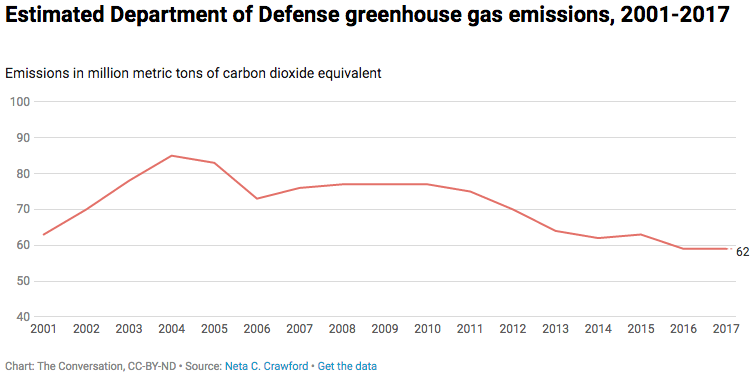New Report Exposes Pentagon’s Massive Contributions to Climate Crisis Post-9/11
ANGLO AMERICA, MILITARISM, ENVIRONMENT, 17 Jun 2019
Jessica Corbett – Common Dreams
Failing to curb the U.S. military’s fossil fuel use, Costs of War Project co-director warns, “will help guarantee the nightmare scenarios” forecast by scientists.

A Luke Air Force Base F-35 Lightning II stands by to take off April 15, 2015, at Nellis Air Force Base, Nev.
(Photo: U.S. Air Force photo/Senior Airman Thomas Spangler)
12 Jun 2019 – From the 2001 launch of the so-called War on Terror to 2017, the Pentagon generated at least 1.2 billion metric tons of greenhouse gases—with annual rates exceeding the planet-warming emissions of industrialized countries such as Portugal or Sweden—according to new research.
Boston University professor Neta C. Crawford details the U.S. Department of Defense’s massive contributions to the global climate emergency in a paper (pdf) published Wednesday by the Costs of War Project at Brown University’s Watson Institute for International and Public Affairs.
“The U.S. military’s energy consumption drives total U.S. government energy consumption,” the paper reads. “The DOD is the single largest consumer of energy in the U.S., and in fact, the world’s single largest institutional consumer of petroleum.”
“Absent any change in U.S. military fuel use policy, the fuel consumption of the U.S. military will necessarily continue to generate high levels of greenhouse gases,” the paper warns. “These greenhouse gases, combined with other U.S. emissions, will help guarantee the nightmare scenarios that the military predicts and that many climate scientists say are possible.”
New research release: Since the beginning of the post-9/11 wars, the U.S. military has emitted 1.2 BILLION metric tons of greenhouse gases. The Pentagon is the world's single largest consumer of oil and a top contributor to climate change. https://t.co/slcY4ehoc2 pic.twitter.com/d09OxS3lCF
— The Costs of War Project (@CostsOfWar) June 12, 2019
Crawford, co-director of the Costs of War Project, estimates U.S. military emissions—which largely come from fueling weapons and equipment as well as operating more than 560,000 buildings around the world—from 1975 to 2017, relying on data from the Energy Department because the Pentagon does not report its fuel consumption numbers to Congress.
In the paper, she also examines patterns of military fuel use since 2001 in relation to emissions and the Pentagon’s views on “climate change as a threat to military installations and operations, as well as to national security, when and if climate change leads mass migration, conflict, and war.”
Writing about her research for The Conversation Wednesday, Crawford noted that DOD’s annual emissions have declined since reaching a peak in 2004, as the Pentagon has, over the past decade, “reduced its fossil fuel consumption through actions that include using renewable energy, weatherizing buildings, and reducing aircraft idling time on runways.”
The paper’s opening summary outlines four major benefits of further decreasing DOD’s fossil fuel use:
- First, the U.S. would reduce greenhouse gas emissions. This would thereby mitigate climate change and its associated threats to national security.
- Second, reducing fossil fuel consumption would have important political and security benefits, including reducing the dependence of troops in the field on oil, which the military acknowledges makes them vulnerable to enemy attacks. If the U.S. military were to significantly decrease its dependence on oil, the U.S. could reduce the political and fuel resources it uses to defend access to oil, particularly in the Persian Gulf, where it concentrates these efforts.
- Third, by decreasing U.S. dependence on oil-rich states the U.S. could then reevaluate the size of the U.S. military presence in the Persian Gulf and reevaluate its relationship with Saudi Arabia and other allies in the region.
- Finally, by spending less money on fuel and operations to provide secure access to petroleum, the U.S. could decrease its military spending and reorient the economy to more economically productive activities.
Crawford, in her piece for The Conversation, concluded that “climate change should be front and center in U.S. national security debates. Cutting Pentagon greenhouse gas emissions will help save lives in the United States, and could diminish the risk of climate conflict.”
She is far from the first to highlight how the Pentagon is fueling the world’s climate crisis and call for urgent reforms. Just last month, Sen. Elizabeth Warren (D-Mass.) released a climate “resiliency and readiness” plan for the U.S. military as part of her 2020 campaign for president. However, as Common Dreams reported at the time, anti-war critics of Warren’s plan charged that “trying to ‘green’ the Pentagon without addressing the destructive impacts of its bloated budget and American imperialism is a misguided way to combat the emergency of global warming.”
Author and advocate Stacy Bannerman, in an op-ed for Common Dreams last year, warned that “if we don’t get serious about stopping the United States War Machine, we could lose the biggest battle of our lives.”
“In order to achieve the massive systemic and cultural transformations required for mitigating climate change and advancing climate justice,” Bannerman wrote, “we’re going to have to deal with the socially sanctioned, institutionalized violence perpetrated by U.S. foreign policy that is pouring fuel on the fire of global warming.”
Our work is licensed under a Creative Commons Attribution-Share Alike 3.0 License. Feel free to republish and share widely.
Go to Original – commondreams.org
Tags: Environment, Military, Pentagon, Pollution, USA, War, West
DISCLAIMER: The statements, views and opinions expressed in pieces republished here are solely those of the authors and do not necessarily represent those of TMS. In accordance with title 17 U.S.C. section 107, this material is distributed without profit to those who have expressed a prior interest in receiving the included information for research and educational purposes. TMS has no affiliation whatsoever with the originator of this article nor is TMS endorsed or sponsored by the originator. “GO TO ORIGINAL” links are provided as a convenience to our readers and allow for verification of authenticity. However, as originating pages are often updated by their originating host sites, the versions posted may not match the versions our readers view when clicking the “GO TO ORIGINAL” links. This site contains copyrighted material the use of which has not always been specifically authorized by the copyright owner. We are making such material available in our efforts to advance understanding of environmental, political, human rights, economic, democracy, scientific, and social justice issues, etc. We believe this constitutes a ‘fair use’ of any such copyrighted material as provided for in section 107 of the US Copyright Law. In accordance with Title 17 U.S.C. Section 107, the material on this site is distributed without profit to those who have expressed a prior interest in receiving the included information for research and educational purposes. For more information go to: http://www.law.cornell.edu/uscode/17/107.shtml. If you wish to use copyrighted material from this site for purposes of your own that go beyond ‘fair use’, you must obtain permission from the copyright owner.
Read more
Click here to go to the current weekly digest or pick another article:
ANGLO AMERICA:
MILITARISM:
- Think Tanks Fueling Endless War - Think Tanks or Stink Tanks?
- Dolphins in the Military
- US Has Given Israel $22 Billion in Military Aid since October 2023
ENVIRONMENT:
